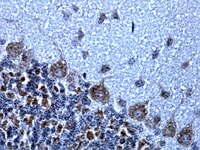Neural circuit interactions between the dorsal raphe nucleus and the lateral hypothalamus: an experimental and computational study.
Jalewa, J; Joshi, A; McGinnity, TM; Prasad, G; Wong-Lin, K; Hölscher, C
PloS one
9
e88003
2014
Show Abstract
Orexinergic/hypocretinergic (Ox) neurotransmission plays an important role in regulating sleep, as well as in anxiety and depression, for which the serotonergic (5-HT) system is also involved in. However, little is known regarding the direct and indirect interactions between 5-HT in the dorsal raphe nucleus (DRN) and Ox neurons in the lateral hypothalamus (LHA). In this study, we report the additional presence of 5-HT1BR, 5-HT2AR, 5-HT2CR and fast ligand-gated 5-HT3AR subtypes on the Ox neurons of transgenic Ox-enhanced green fluorescent protein (Ox-EGFP) and wild type C57Bl/6 mice using single and double immunofluorescence (IF) staining, respectively, and quantify the colocalization for each 5-HT receptor subtype. We further reveal the presence of 5-HT3AR and 5-HT1AR on GABAergic neurons in LHA. We also identify NMDAR1, OX1R and OX2R on Ox neurons, but none on adjacent GABAergic neurons. This suggests a one-way relationship between LHA's GABAergic and Ox neurons, wherein GABAergic neurons exerts an inhibitory effect on Ox neurons under partial DRN's 5-HT control. We also show that Ox axonal projections receive glutamatergic (PSD-95 immunopositive) and GABAergic (Gephyrin immunopositive) inputs in the DRN. We consider these and other available findings into our computational model to explore possible effects of neural circuit connection types and timescales on the DRN-LHA system's dynamics. We find that if the connections from 5-HT to LHA's GABAergic neurons are weakly excitatory or inhibitory, the network exhibits slow oscillations; not observed when the connection is strongly excitatory. Furthermore, if Ox directly excites 5-HT neurons at a fast timescale, phasic Ox activation can lead to an increase in 5-HT activity; no significant effect with slower timescale. Overall, our experimental and computational approaches provide insights towards a more complete understanding of the complex relationship between 5-HT in the DRN and Ox in the LHA. | 24516577
 |
Acute mechanisms underlying antibody effects in anti-N-methyl-D-aspartate receptor encephalitis.
Moscato, EH; Peng, X; Jain, A; Parsons, TD; Dalmau, J; Balice-Gordon, RJ
Annals of neurology
76
108-19
2014
Show Abstract
A severe but treatable form of immune-mediated encephalitis is associated with antibodies in serum and cerebrospinal fluid (CSF) against the GluN1 subunit of the N-methyl-D-aspartate receptor (NMDAR). Prolonged exposure of hippocampal neurons to antibodies from patients with anti-NMDAR encephalitis caused a reversible decrease in the synaptic localization and function of NMDARs. However, acute effects of the antibodies, fate of the internalized receptors, type of neurons affected, and whether neurons develop compensatory homeostatic mechanisms were unknown and are the focus of this study.Dissociated hippocampal neuron cultures and rodent brain sections were used for immunocytochemical, physiological, and molecular studies.Patient antibodies bind to NMDARs throughout the rodent brain, and decrease NMDAR cluster density in both excitatory and inhibitory hippocampal neurons. They rapidly increase the internalization rate of surface NMDAR clusters, independent of receptor activity. This internalization likely accounts for the observed decrease in NMDAR-mediated currents, as no evidence of direct blockade was detected. Once internalized, antibody-bound NMDARs traffic through both recycling endosomes and lysosomes, similar to pharmacologically induced NMDAR endocytosis. The antibodies are responsible for receptor internalization, as their depletion from CSF abrogates these effects in hippocampal neurons. We find that although anti-NMDAR antibodies do not induce compensatory changes in glutamate receptor gene expression, they cause a decrease in inhibitory synapse density onto excitatory hippocampal neurons.Our data support an antibody-mediated mechanism of disease pathogenesis driven by immunoglobulin-induced receptor internalization. Antibody-mediated downregulation of surface NMDARs engages homeostatic synaptic plasticity mechanisms, which may inadvertently contribute to disease progression. | 24916964
 |











